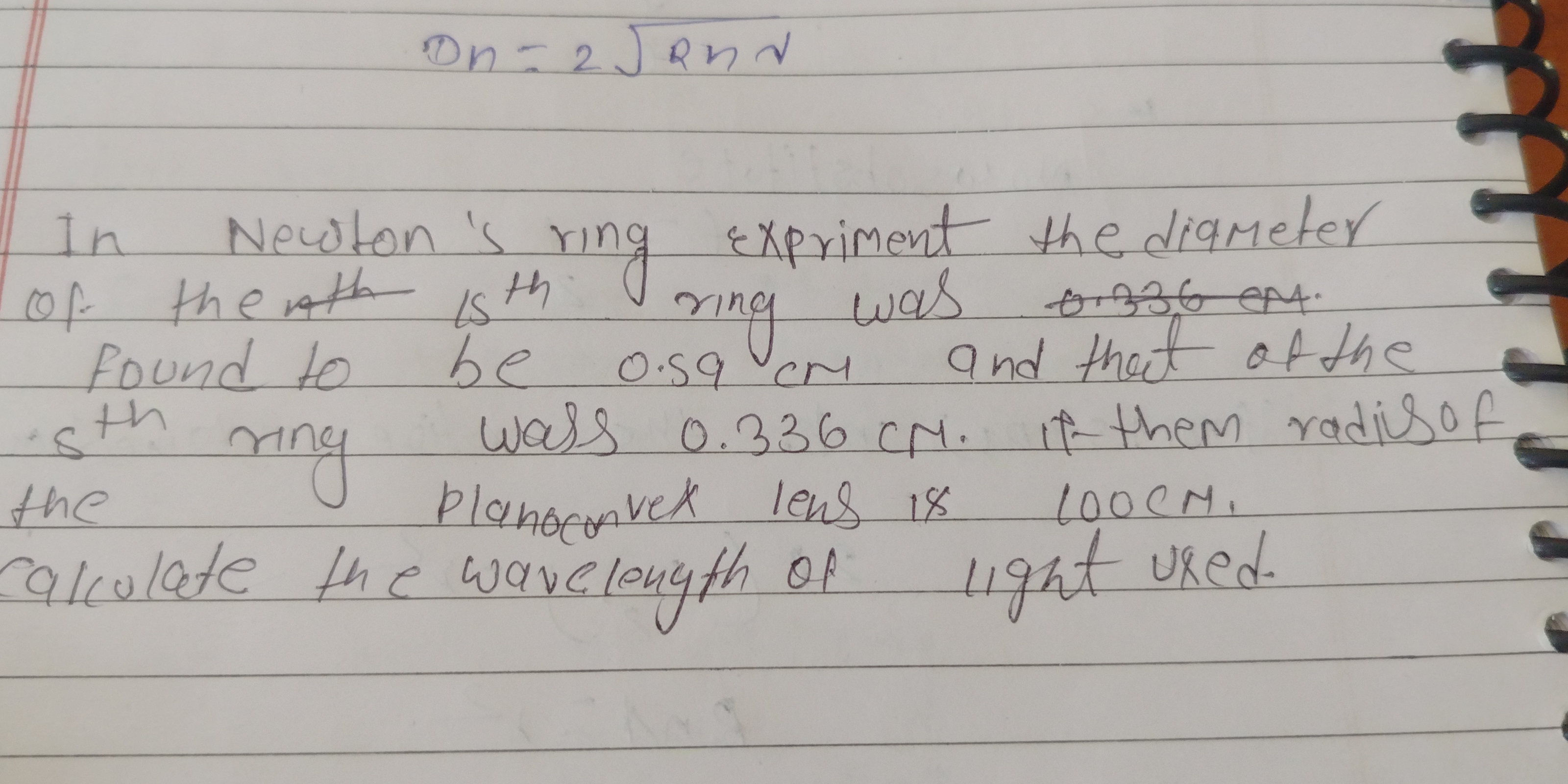In Newton's ring experiment, the diameter of the 18th ring was found to be 0.59 cm and that of the 8th ring was 0.336 cm. If the radius of the plano-convex lens is 100 cm, calculat... In Newton's ring experiment, the diameter of the 18th ring was found to be 0.59 cm and that of the 8th ring was 0.336 cm. If the radius of the plano-convex lens is 100 cm, calculate the wavelength of the light used.

Understand the Problem
The question describes a Newton's rings experiment and provides the diameters of the 18th ring and the 8th ring. It also gives the radius of curvature of the plano-convex lens. The task is to calculate the wavelength of the light used in the experiment.
Answer
$\lambda = 5880.1 \, \text{Å}$
Answer for screen readers
$\lambda = 5880.1 , \text{Å}$
Steps to Solve
- Write down the given information
Diameter of the 18th ring, $D_{18} = 0.59 , \text{cm}$ Diameter of the 8th ring, $D_8 = 0.336 , \text{cm}$ Radius of curvature of the plano-convex lens, $R = 100 , \text{cm}$
- Formula for the diameter of the $n^{th}$ ring
The formula for the diameter of the $n^{th}$ bright ring in Newton's rings experiment is given by: $$D_n^2 = 4nR\lambda$$ where $D_n$ is the diameter of the $n^{th}$ ring, $R$ is the radius of curvature of the lens, $\lambda$ is the wavelength of the light used, and $n$ is the ring number.
- Apply the formula for the 18th and 8th rings
For the 18th ring ($n = 18$): $$D_{18}^2 = 4(18)R\lambda$$ $$(0.59 , \text{cm})^2 = 4(18)(100 , \text{cm})\lambda$$
For the 8th ring ($n = 8$): $$D_8^2 = 4(8)R\lambda$$ $$(0.336 , \text{cm})^2 = 4(8)(100 , \text{cm})\lambda$$
- Subtract the two equations to eliminate unknowns
Subtract the equation for the 8th ring from the equation for the 18th ring: $$D_{18}^2 - D_8^2 = 4R\lambda(18 - 8)$$ $$(0.59)^2 - (0.336)^2 = 4(100)\lambda(10)$$ $$0.3481 - 0.112896 = 4000\lambda$$ $$0.235204 = 4000\lambda$$
- Solve for $\lambda$
$$\lambda = \frac{0.235204}{4000}$$ $$\lambda = 0.000058801 , \text{cm}$$ $$\lambda = 5.8801 \times 10^{-5} , \text{cm}$$
- Convert cm to Angstroms
Since $1 , \text{cm} = 10^8 , \text{Angstroms (Å)}$, $$\lambda = 5.8801 \times 10^{-5} \times 10^8 , \text{Å}$$ $$\lambda = 5880.1 , \text{Å}$$
$\lambda = 5880.1 , \text{Å}$
More Information
The wavelength of the light used in the experiment is approximately 5880.1 Angstroms. This falls within the visible light spectrum, specifically in the yellow-orange range.
Tips
A common mistake is to forget to convert all measurements to the same units before performing calculations. Another mistake is using the wrong formula or mixing up the diameters of the rings. Also, the formula used is valid for dark rings, not bright rings.
AI-generated content may contain errors. Please verify critical information